I Am the Smith That Fashions a Weapon
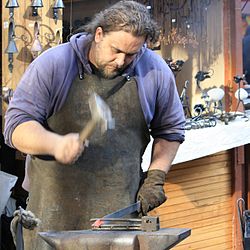 A modernistic blacksmith exhibiting at a market stall | |
| Occupation | |
|---|---|
| Occupation type | Profession |
| Activeness sectors | Vocation |
| Description | |
| Competencies | Physical strength, conceptualization |
| Fields of | Creative person, Craftsman |
| Related jobs | Farrier |
A blacksmith is a metalsmith who creates objects primarily from wrought iron or steel, but sometimes from other metals, by forging the metallic, using tools to hammer, bend, and cutting (cf. tinsmith). Blacksmiths produce objects such as gates, grilles, railings, light fixtures, furniture, sculpture, tools, agricultural implements, decorative and religious items, cooking utensils, and weapons. There was an historical opposition between the heavy piece of work of the blacksmith and the more than frail operation of a whitesmith, who usually worked in aureate, silverish, pewter, or the finishing steps of fine steel.[1] The place where a blacksmith works is called variously a smithy, a forge or a blacksmith'due south shop.
While at that place are many people who piece of work with metallic such as farriers, wheelwrights, and armorers, in former times the blacksmith had a general knowledge of how to brand and repair many things, from the almost circuitous of weapons and armor to simple things similar nails or lengths of chain.

Statue of a blacksmith (Monument to John Cockerill in Brussels).
Etymology
The "black" in "blacksmith" refers to the black firescale[ citation needed ], a layer of oxides that forms on the surface of the metal during heating. The origin of "smith" is debated, it may come up from the old English language word "smythe" meaning "to strike"[ citation needed ] or it may have originated from the Proto-German "smithaz" meaning "skilled worker."[ii]
Smithing procedure
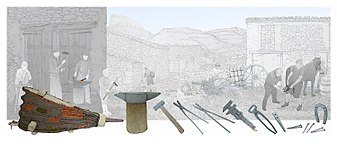
Blacksmiths work by heating pieces of wrought iron or steel until the metal becomes soft plenty for shaping with manus tools, such as a hammer, an anvil and a chisel. Heating generally takes place in a forge fueled past propane, natural gas, coal, charcoal, coke, or oil.
Some modern blacksmiths may also employ an oxyacetylene or similar blowtorch for more localized heating. Induction heating methods are gaining popularity among modern blacksmiths.
Colour is of import for indicating the temperature and workability of the metallic. Equally iron heats to higher temperatures, it commencement glows ruby, and so orangish, yellow, and finally white. The ideal rut for most forging is the bright yellow-orange colour that indicates forging heat. Because they must be able to see the glowing color of the metallic, some blacksmiths work in dim, low-low-cal conditions, but most work in well-lit atmospheric condition. The central is to take consistent lighting, but non too bright. Straight sunlight obscures the colors.
The techniques of smithing can be roughly divided into forging (sometimes chosen "sculpting"), welding, heat-treating, and finishing.
Forging
A blacksmith forging in Brazil, in 2015
Forging—the process smiths use to shape metal by hammering—differs from machining in that forging does not remove textile. Instead, the smith hammers the fe into shape. Even punching and cutting operations (except when trimming waste) by smiths usually re-arrange metallic around the hole, rather than drilling information technology out as swarf.
Forging uses seven basic operations or techniques:
- Drawing downwardly
- Shrinking (a blazon of upsetting)
- Bending
- Upsetting
- Swaging
- Punching
- Forge welding
These operations generally require at least a hammer and anvil, but smiths as well use other tools and techniques to arrange odd-sized or repetitive jobs.
Drawing

Traditional blacksmith side by side to his forge of rock and brick
Drawing lengthens the metal by reducing ane or both of the other ii dimensions. As the depth is reduced, or the width narrowed, the piece is lengthened or "drawn out."
Equally an case of drawing, a smith making a chisel might flatten a square bar of steel, lengthening the metallic, reducing its depth but keeping its width consequent.
Drawing does not have to be uniform. A taper can result equally in making a wedge or a woodworking chisel bract. If tapered in ii dimensions, a point results.
Drawing can exist accomplished with a variety of tools and methods. Two typical methods using just hammer and anvil would exist hammering on the anvil horn, and hammering on the anvil face using the cross peen of a hammer.
Some other method for cartoon is to use a tool called a fuller, or the peen of the hammer, to hasten the drawing out of a thick piece of metallic. (The technique is chosen fullering from the tool.) Fullering consists of hammering a serial of indentations with respective ridges, perpendicular to the long section of the slice existence drawn. The resulting effect looks somewhat like waves along the pinnacle of the piece. And so the smith turns the hammer over to apply the flat face to hammer the tops of the ridges down level with the bottoms of the indentations. This forces the metal to abound in length (and width if left unchecked) much faster than but hammering with the flat face up of the hammer.
Bending

Canadian blacksmith in the 1970s
Heating iron to a "forging heat" allows bending every bit if it were a soft, ductile metal, like copper or silver.
Bending tin can be washed with the hammer over the horn or edge of the anvil or by inserting a bending fork into the hardy hole (the square hole in the top of the anvil), placing the work slice betwixt the tines of the fork, and bending the textile to the desired angle. Bends can be dressed and tightened, or widened, past hammering them over the appropriately shaped office of the anvil.
Some metals are "hot short", meaning they lose their tensile force when heated. They go like Plasticine: although they may yet be manipulated by squeezing, an endeavour to stretch them, even past angle or twisting, is likely to take them fissure and interruption apart. This is a problem for some blade-making steels, which must be worked carefully to avoid developing hidden cracks that would cause failure in the futurity. Though rarely hand-worked, titanium is notably hot short. Fifty-fifty such common smithing processes as decoratively twisting a bar are incommunicable with it.
Upsetting
Upsetting is the procedure of making metal thicker in 1 dimension through shortening in the other. One form is to heat the terminate of a rod and then hammer on it as 1 would drive a nail: the rod gets shorter, and the hot function widens. An alternative to hammering on the hot end is to place the hot end on the anvil and hammer on the common cold finish.
Punching
Punching may exist done to create a decorative pattern, or to make a hole. For case, in preparation for making a hammerhead, a smith would punch a hole in a heavy bar or rod for the hammer handle. Punching is not express to depressions and holes. It likewise includes cutting, slitting, and drifting—all done with a chisel.
Combining processes
The five bones forging processes are often combined to produce and refine the shapes necessary for finished products. For instance, to style a cross-peen hammer head, a smith would starting time with a bar roughly the diameter of the hammer face up: the handle hole would exist punched and drifted (widened past inserting or passing a larger tool through it), the head would be cut (punched, but with a wedge), the peen would exist drawn to a wedge, and the confront would be dressed past upsetting.
As with making a chisel, since information technology is lengthened by drawing it would also tend to spread in width. A smith would therefore oft plough the chiselhoped-for on its side and hammer it back down—upsetting it—to check the spread and keep the metal at the correct width.
Or, if a smith needed to put a 90-degree bend in a bar and wanted a sharp corner on the exterior of the curve, they would begin by hammering an unsupported end to make the curved bend. So, to "fatten up" the exterior radius of the bend, one or both arms of the bend would need to be pushed back to fill the outer radius of the curve. And so they would hammer the ends of the stock downwardly into the curve, 'upsetting' it at the point of the bend. They would then dress the bend past drawing the sides of the curve to keep the correct thickness. The hammering would continue—upsetting and then drawing—until the bend had been properly shaped. In the master functioning was the bend, but the drawing and upsetting are washed to refine the shape.
Welding
Welding is the joining of the same or similar kind of metallic.
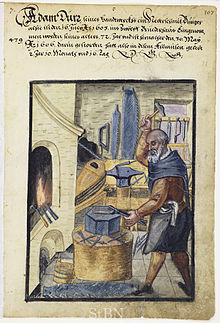
A modern blacksmith has a range of options and tools to achieve this. The basic types of welding normally employed in a modern workshop include traditional forge welding besides equally modern methods, including oxyacetylene and arc welding.
In forge welding, the pieces to bring together are heated to what is generally referred to as welding heat. For mild steel nigh smiths judge this temperature by color: the metal glows an intense yellow or white. At this temperature the steel is almost molten.
Any strange material in the weld, such every bit the oxides or "scale" that typically form in the fire, can weaken it and cause information technology to fail. Thus the mating surfaces to be joined must be kept clean. To this finish a smith makes certain the burn down is a reducing fire: a fire where, at the heart, in that location is a smashing bargain of rut and very little oxygen. The smith also carefully shapes mating faces and so that equally they come together foreign material squeezes out as the metal is joined. To clean the faces, protect them from oxidation, and provide a medium to carry foreign textile out of the weld, the smith sometimes uses flux—typically powdered borax, silica sand, or both.
The smith first cleans parts to be joined with a wire brush, then puts them in the fire to heat. With a mix of drawing and upsetting the smith shapes the faces so that when finally brought together, the center of the weld connects offset and the connectedness spreads outward nether the hammer blows, pushing out the flux (if used) and strange material.
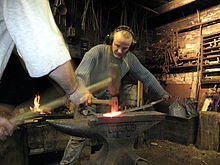
An creative person blacksmith and a striker working as one
The dressed metal goes dorsum in the fire, is brought near to welding rut, removed from the fire, and brushed. Flux is sometimes practical, which prevents oxygen from reaching and burning the metal during forging, and it is returned to the burn. The smith now watches carefully to avoid overheating the metal. There is some challenge to this because, to see the color of the metal, the smith must remove it from the fire—exposing information technology to air, which can rapidly oxidize it. And then the smith might probe into the burn down with a bit of steel wire, prodding lightly at the mating faces. When the finish of the wire sticks on to the metal, it is at the right temperature (a modest weld forms where the wire touches the mating face, and then information technology sticks). The smith unremarkably places the metallic in the fire then he can see it without letting surrounding air contact the surface. (Note that smiths don't always utilize flux, especially in the UK.) At present the smith moves with rapid purpose, quickly taking the metal from the burn to the anvil and bringing the mating faces together. A few light hammer taps bring the mating faces into complete contact and squeeze out the flux—and finally, the smith returns the work to the fire. The weld begins with the taps, just frequently the joint is weak and incomplete, so the smith reheats the joint to welding temperature and works the weld with light blows to "set" the weld and finally to dress information technology to the shape.
Finishing
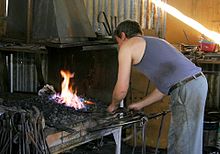
Depending on the intended employ of the piece, a blacksmith may finish it in a number of ways:
- A simple jig (a tool) that the smith might only use a few times in the shop may get the minimum of finishing—a rap on the anvil to intermission off scale and a brushing with a wire castor.
- Files bring a piece to concluding shape, removing burrs and sharp edges, and smoothing the surface.
- Heat treatment and case-hardening reach the desired hardness.
- The wire brush—as a hand tool or power tool—can farther smoothen, brighten, and smoothen surfaces.
- Grinding stones, abrasive paper, and emery wheels tin further shape, polish, and polish the surface.
A range of treatments and finishes can inhibit oxidation and enhance or change the appearance of the slice. An experienced smith selects the finish based on the metal and on the intended use of the item. Finishes include (among others): pigment, varnish, bluing, browning, oil, and wax.
Blacksmith'south striker

A blacksmith's striker is an assistant (frequently an apprentice) whose job is to swing a big sledgehammer in heavy forging operations, as directed by the blacksmith. In practice, the blacksmith holds the hot iron at the anvil (with tongs) in one hand, and indicates where to strike the iron by tapping information technology with a small hammer in the other hand. The striker and so delivers a heavy blow to the indicated spot with a sledgehammer. During the 20th century and into the 21st century, this function has become increasingly unnecessary and automatic through the use of trip hammers or reciprocating ability hammers.
Blacksmith's materials
When iron ore is smelted into usable metal, a certain corporeality of carbon is usually alloyed with the fe. (Charcoal is almost pure carbon.) The amount of carbon significantly affects the properties of the metallic. If the carbon content is over two%, the metal is called cast iron, because it has a relatively low melting betoken and is easily cast. It is quite brittle, even so, and cannot be forged so therefore non used for blacksmithing. If the carbon content is betwixt 0.25% and 2%, the resulting metallic is tool steel, which can exist heat treated as discussed above. When the carbon content is below 0.25%, the metal is either "wrought fe (wrought iron is not smelted and cannot come from this process) " or "mild steel." The terms are never interchangeable. In preindustrial times, the material of option for blacksmiths was wrought iron. This iron had a very low carbon content, and besides included up to v% of glassy fe silicate slag in the form of numerous very fine stringers. This slag content made the iron very tough, gave information technology considerable resistance to rusting, and immune it to exist more easily "forge welded," a procedure in which the blacksmith permanently joins two pieces of iron, or a piece of iron and a slice of steel, by heating them most to a white oestrus and hammering them together. Forge welding is more than difficult with modern balmy steel, because it welds in a narrower temperature ring. The fibrous nature of wrought iron required knowledge and skill to properly form whatsoever tool which would be bailiwick to stress. Modern steel is produced using either the blast furnace or arc furnaces. Wrought iron was produced by a labor-intensive process called puddling, then this cloth is now a difficult-to-find specialty production. Modern blacksmiths generally substitute mild steel for making objects traditionally of wrought atomic number 26. Sometimes they use electrolytic-process pure iron.
Other metals
Many blacksmiths also contain materials such as bronze, copper, or brass in artistic products. Aluminum and titanium may likewise be forged by the blacksmith's process. Bronze is an alloy of copper and tin, while brass is an blend of copper and zinc. Each material responds differently under the hammer and must be separately studied by the blacksmith.
Terminology
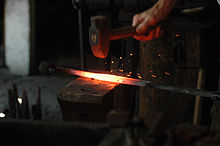
Hot metal work from a blacksmith
- Iron is a naturally occurring metallic element. It is almost never found in its native form (pure iron) in nature. It is usually found equally an oxide or sulfide, with many other impurity elements mixed in.
- Wrought fe is the purest form of iron generally encountered or produced in quantity. It may contain equally petty equally 0.04% carbon (past weight). From its traditional method of industry, wrought iron has a fibrous internal texture. Quality wrought-iron blacksmithing takes the direction of these fibers into account during forging, since the force of the material is stronger in line with the grain than across the grain. Most of the remaining impurities from the initial smelting become concentrated in silicate slag trapped between the iron fibers. This slag produces a lucky side effect during forge-welding. When the silicate melts, it makes wrought iron self-fluxing. The slag becomes a liquid glass that covers the exposed surfaces of the wrought atomic number 26, preventing oxidation which would otherwise interfere with the successful welding process.
- Steel is an alloy of fe and betwixt 0.3% and 1.7% carbon by weight. The presence of carbon allows steel to assume one of several different crystalline configurations. Macroscopically, this is seen as the ability to "plow the hardness of a piece of steel on and off" through various processes of heat-treatment. If the concentration of carbon is held abiding, this is a reversible process. Steel with a higher carbon percentage may be brought to a higher country of maximum hardness.[three]
- Cast fe is iron that contains betwixt 2.0% to 6% carbon by weight. At that place is then much carbon present that the hardness cannot exist switched off. Hence, cast iron is a brittle metal, which can pause similar drinking glass. Cast iron cannot exist forged without special heat treatment to catechumen it to malleable iron.[three]
Steel with less than 0.6% carbon content cannot exist hardened plenty by simple oestrus-treatment to make useful hardened-steel tools. Hence, in what follows, wrought-iron, depression-carbon-steel, and other soft unhardenable iron varieties are referred to indiscriminately as merely iron.
History, prehistory, organized religion, and mythology
Mythology
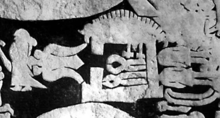
Wayland's smithy in the centre, Níðuð's daughter Böðvildr to the left, and Níðuð's dead sons subconscious to the right of the smithy. Betwixt the girl and the smithy, Wayland can be seen in an hawkeye fetch flight away. From the Ardre paradigm stone VIII on Gotland
In Hindu mythology, Tvastar too known as Vishvakarma is the blacksmith of the devas. The earliest references of Tvastar can be found in the Rigveda.
Hephaestus (Latin: Vulcan) was the blacksmith of the gods in Greek and Roman mythology. A supremely skilled artisan whose forge was a volcano, he synthetic most of the weapons of the gods, also equally beautiful assistants for his smithy and a metal fishing-net of astonishing intricacy. He was the god of metalworking, fire, and craftsmen.
In Celtic mythology, the role of Smith is held past eponymous (their names do hateful 'smith') characters : Goibhniu (Irish myths of the Tuatha Dé Danann wheel) or Gofannon (Welsh myths/ the Mabinogion). Brigid or Brigit, an Irish gaelic goddess, is sometimes described every bit the patroness of blacksmiths.[four]
In the Nart mythology of the Caucasus the hero known to the Ossetians as Kurdalægon and the Circassians as Tlepsh is a blacksmith and skilled craftsman whose exploits exhibit shamanic features, sometimes bearing comparison to those of the Scandinavian deity Odin. 1 of his greatest feats is interim as a type of male midwife to the hero Xamyc, who has been fabricated the carrier of the embryo of his son Batraz by his dying married woman the water-sprite Lady Isp, who spits information technology between his shoulder blades, where it forms a womb-like cyst. Kurdalaegon prepares a type of tower or scaffold above a quenching bath for Xamyc, and, when the time is right, lances the cyst to liberate the infant hero Batraz as a newborn babe of white-hot steel, whom Kurdalægon then quenches like a newly forged sword.[5]
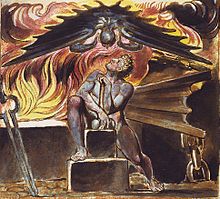
The Anglo-Saxon Wayland Smith, known in Old Norse equally Völundr, is a heroic blacksmith in Germanic mythology. The Poetic Edda states that he forged beautiful aureate rings ready with wonderful gems. He was captured by king Níðuðr, who cruelly hamstrung him and imprisoned him on an isle. Völundr eventually had his revenge by killing Níðuðr's sons and fashioning goblets from their skulls, jewels from their eyes and a brooch from their teeth. He then raped the male monarch's daughter, after drugging her with strong beer, and escaped, laughing, on wings of his ain making, boasting that he had fathered a child upon her.
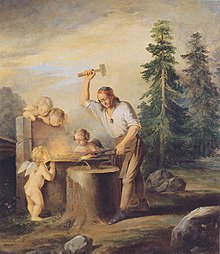
Seppo Ilmarinen, the Eternal Hammerer, blacksmith and inventor in the Kalevala, is an archetypal artificer from Finnish mythology.[viii]
Tubal-Cain is mentioned in the volume of Genesis of the Torah as the original smith.
Ogun, the god of blacksmiths, warriors, hunters and others who work with iron is one of the pantheon of Orisha traditionally worshipped past the Yoruba people of Nigeria.
Before the Iron Age
Gold, silver, and copper all occur in nature in their native states, as reasonably pure metals – humans probably worked these metals first. These metals are all quite malleable, and humans' initial development of hammering techniques was undoubtedly practical to these metals.
During the Chalcolithic era and the Bronze Historic period, humans in the Mideast learned how to smelt, melt, cast, rivet, and (to a limited extent) forge copper and bronze. Statuary is an alloy of copper and approximately 10% to 20% Tin. Bronze is superior to just copper, by existence harder, being more resistant to corrosion, and past having a lower melting betoken (thereby requiring less fuel to melt and cast). Much of the copper used by the Mediterranean World came from the island of Cyprus. Most of the tin can came from the Cornwall region of the island of Great Britain, transported by sea-borne Phoenician and Greek traders.
Copper and bronze cannot be hardened by oestrus-treatment, they tin only be hardened by cold working. To achieve this, a piece of bronze is lightly hammered for a long period of fourth dimension. The localized stress-cycling causes work hardening by changing the size and shape of the metal's crystals. The hardened bronze can and then be footing to sharpen it to make edged tools.
Clocksmiths as recently as the 19th century used piece of work hardening techniques to harden the teeth of brass gears and ratchets. Borer on just the teeth produced harder teeth, with superior wear-resistance. By contrast, the rest of the gear was left in a softer and tougher country, more capable of resisting smashing.
Bronze is sufficiently corrosion-resistant that artifacts of bronze may final thousands of years relatively unscathed. Accordingly, museums oft preserve more examples of Bronze Historic period metallic-piece of work than examples of artifacts from the much younger Iron Age. Cached iron artifacts may completely rust away in less than 100 years. Examples of aboriginal iron work still extant are very much the exception to the norm.
Iron Age
Concurrent with the advent of alphabetic characters in the Iron Age, humans became enlightened of the metal atomic number 26. However, in before ages, iron's qualities, in contrast to those of statuary, were not by and large understood. Atomic number 26 artifacts, composed of meteoric iron, have the chemical composition containing up to xl% nickel. Every bit this source of this atomic number 26 is extremely rare and fortuitous, little development of smithing skills peculiar to iron can be assumed to have occurred. That we still possess whatever such artifacts of meteoric iron may be ascribed to the vagaries of climate, and the increased corrosion-resistance conferred on iron by the presence of nickel.
During the (north) Polar Exploration of the early 20th century, Inughuit, northern Greenlandic Inuit, were found to be making fe knives from 2 especially large nickel-iron meteors.[9] One of these meteors was taken to Washington, D.C., where it was remitted to the custody of the Smithsonian Institution.
The Hittites of Anatolia beginning discovered or developed the smelting of iron ores effectually 1500 BC. They seem to have maintained a well-nigh monopoly on the knowledge of iron production for several hundred years, merely when their empire collapsed during the Eastern Mediterranean upheavals around 1200 BC, the noesis seems to take escaped in all directions.
In the Iliad of Homer (describing the Trojan War and Bronze Age Greek and Trojan warriors), almost of the armor and weapons (swords and spears) are stated to have been of statuary. Iron is non unknown, even so, as arrowheads are described as iron, and a "ball of atomic number 26" is listed as a prize awarded for winning a contest. The events described probably occurred around 1200 BC, but Homer is thought to have composed this epic poem around 700 BC; then exactitude must remain suspect.

When historical records resume after the 1200 BC upheavals and the ensuing Greek Dark Historic period, iron work (and presumably blacksmiths) seem to accept sprung similar Athena, fully-grown from the caput of Zeus. Very few artifacts remain, due to loss from corrosion, and re-use of iron as a valuable commodity. What information exists indicates that all of the basic operations of blacksmithing were in utilize every bit soon as the Iron Age reached a particular locality. The scarcity of records and artifacts, and the rapidity of the switch from Bronze Age to Iron Age, is a reason to utilise testify of bronze smithing to infer near the early development of blacksmithing.
It is uncertain when Iron weapons replaced Bronze weapons considering the earliest Iron swords did non significantly improve on the qualities of existing statuary artifacts. Unalloyed iron is soft, does non hold an edge equally well as a properly synthetic bronze blade and needs more maintenance. Atomic number 26 ores are more widely available than the necessary materials to create statuary however, which made iron weapons more than economic than comparable bronze weapons. Small amounts of steel are oft formed during several of the earliest refining practices, and when the backdrop of this alloy were discovered and exploited, steel edged weapons greatly outclassed bronze.
Iron is unlike from about other materials (including bronze), in that it does not immediately go from a solid to a liquid at its melting point. H2O is a solid (water ice) at -1 C (31 F), and a liquid (water) at +1 C (33 F). Iron, past contrast, is definitely a solid at 800 °F (427 °C), but over the next 1,500 °F (820 °C) it becomes increasingly plastic and more "taffy-like" as its temperature increases. This extreme temperature range of variable solidity is the fundamental material belongings upon which blacksmithing practice depends.
Another major departure between bronze and fe fabrication techniques is that bronze can be melted. The melting indicate of iron is much higher than that of statuary. In the western (Europe & the Mideast) tradition, the engineering to make fires hot enough to melt iron did non arise until the 16th century, when smelting operations grew large plenty to require overly big bellows. These produced blast-furnace temperatures loftier enough to cook partially refined ores, resulting in bandage iron. Thus cast iron frying pans and cookware did not become possible in Europe until 3000 years after the introduction of iron smelting. Cathay, in a separate developmental tradition, was producing cast iron at least 1000 years before this.
Although iron is quite abundant, skillful quality steel remained rare and expensive until the industrial developments of Bessemer process et al. in the 1850s. Shut test of blacksmith-made antique tools clearly shows where small pieces of steel were forge-welded into iron to provide the hardened steel cutting edges of tools (notably in axes, adzes, chisels, etc.). The re-use of quality steel is another reason for the lack of artifacts.
The Romans (who ensured that their ain weapons were made with practiced steel) noted (in the 4th century BC) that the Celts of the Po River Valley had iron, but non skilful steel. The Romans record that during boxing, their Celtic opponents could simply swing their swords 2 or three times before having to step on their swords to straighten them.
On the Indian subcontinent, Wootz steel was, and continues to be, produced in small quantities.
In south asia and western Africa, blacksmiths form endogenous castes that sometimes speak singled-out languages.
Medieval period

A blacksmith monk, from a medieval French manuscript
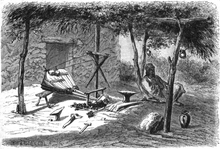
In the medieval period, blacksmithing was considered function of the set of seven mechanical arts.
Prior to the industrial revolution, a "village smithy" was a staple of every town. Factories and mass-product reduced the demand for blacksmith-fabricated tools and hardware.
The original fuel for forge fires was charcoal. Coal did not brainstorm to supercede charcoal until the forests of first United kingdom (during the AD 17th century), so the eastern U.s.a. of America (during the 19th century) were largely depleted. Coal can be an junior fuel for blacksmithing, considering much of the world's coal is contaminated with sulfur. Sulfur contamination of iron and steel make them "blood-red short", then that at red heat they become "crumbly" instead of "plastic". Coal sold and purchased for blacksmithing should exist largely gratuitous of sulfur.
European blacksmiths earlier and through the medieval era spent a great deal of time heating and hammering iron before forging it into finished articles. Although they were unaware of the chemical footing, they were aware that the quality of the atomic number 26 was thus improved. From a scientific indicate of view, the reducing temper of the forge was both removing oxygen (rust), and soaking more carbon into the fe, thereby developing increasingly college grades of steel every bit the process was continued.
Industrial era
During the eighteenth century, agents for the Sheffield cutlery industry scoured the British country-side, offering new carriage springs for old. Springs must exist fabricated of hardened steel. At this fourth dimension, the processes for making steel produced an extremely variable product—quality was not ensured at the initial signal of sale. Springs that had survived nifty through hard utilise over the rough roads of the fourth dimension, had proven to be of a amend quality steel. Much of the fame of Sheffield cutlery (knives, shears, etc.) was due to the extreme lengths the companies took to ensure they used high-grade steel.[ citation needed ]

During the first half of the nineteenth century, the Us authorities included in their treaties with many Native American tribes, that the U.s.a. would use blacksmiths and strikers at Army forts, with the expressed purpose of providing Native Americans with atomic number 26 tools and repair services.[ commendation needed ]
During the early to mid-nineteenth century, both European armies[ten] as well every bit both the U.S. Federal and Confederate armies employed blacksmiths to shoe horses and repair equipment such every bit wagons, horse tack, and artillery equipment. These smiths primarily worked at a traveling forge that when combined with a limber, comprised wagons specifically designed and constructed as blacksmith shops on wheels to carry the essential equipment necessary for their work.[11] [12] [13]
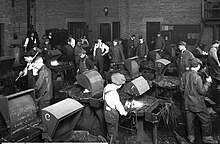
Lathes, patterned largely on their woodturning counterparts, had been used by some blacksmiths[fourteen] [ commendation needed ] since the heart-ages. During the 1790s Henry Maudslay created the commencement screw-cutting lathe, a watershed consequence that signaled the start of blacksmiths being replaced by machinists in factories for the hardware needs of the populace.
Samuel Colt neither invented nor perfected interchangeable parts, just his insistence (and other industrialists at this time) that his firearms be manufactured with this property, was another footstep towards the obsolescence of metal-working artisans and blacksmiths. (See also Eli Whitney).
As demand for their products declined, many more than blacksmiths augmented their incomes past taking in work shoeing horses. A shoer-of-horses was historically known as a farrier in English. With the introduction of automobiles, the number of blacksmiths continued to decrease, many erstwhile blacksmiths becoming the initial generation of automobile Mechanics. The nadir of blacksmithing in the Usa was reached during the 1960s, when near of the erstwhile blacksmiths had left the trade, and few if whatever new people were entering the trade. Past this time, most of the working blacksmiths were those performing farrier piece of work, then the term blacksmith was effectively co-opted by the farrier trade.
Neoclassicism era
In the concluding part of the 18th century, forged ironwork continued to decline due to the aforementioned industrial revolution, shapes of the elements in the designs of window grilles and other decorative functional items connected to contradict natural forms, surfaces begin to exist covered in pigment, cast iron elements are incorporated into the forged designs.
Main features of Neoclassicism ironwork (also referred to as Louis XVI style and Empire style ironwork) include smoothen straight confined, decorative geometric elements, double or oval volutes and the usage of elements from Classical antiquity (Meander (art), wreaths etc.).
Typical for this kind of ironwork is that the ironwork is painted white with golden (gold) elements.[fifteen]
20th and 21st centuries

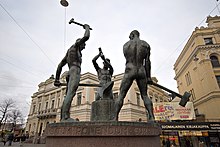
During the 20th century diverse gases (natural gas, acetylene, etc.) have also come to exist used as fuels for blacksmithing. While these are fine for blacksmithing iron, special care must be taken when using them to blacksmith steel. Each time a piece of steel is heated, in that location is a trend for the carbon content to leave the steel (decarburization). This can leave a piece of steel with an effective layer of unhardenable iron on its surface. In a traditional charcoal or coal forge, the fuel is really just carbon. In a properly regulated charcoal/coal burn, the air in and immediately around the fire should exist a reducing temper. In this example, and at elevated temperatures, there is a tendency for vaporized carbon to soak into steel and atomic number 26, counteracting or negating the decarburizing tendency. This is similar to the process by which a case of steel is developed on a piece of atomic number 26 in training for case hardening.
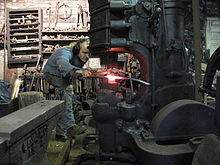
An Artist Blacksmith working with a power hammer in Bodom, Finland, 2011
A renewed interest in blacksmithing occurred every bit part of the trend in "do-it-yourself" and "self-sufficiency" that occurred during the 1970s. Currently there are many books, organizations and individuals working to assist educate the public about blacksmithing, including local groups of smiths who have formed clubs, with some of those smiths demonstrating at historical sites and living history events. Some modern blacksmiths who produce decorative metalwork refer to themselves as creative person-blacksmiths. In 1973 the Artists Blacksmiths' Association of North America was formed with 27 members. Past 2013 information technology had almost 4000 members. Too the British Artist Blacksmiths Association was created in 1978, with 30 charter members and had about 600 members in 2013[xvi] and publish for members a quarterly mag.
While developed nations saw a decline and re-awakening of involvement in blacksmithing, in many developing nations blacksmiths continued doing what blacksmiths have been doing for 3500 years: making and repairing iron and steel tools and hardware for people in their local surface area.
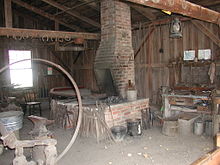
Notable blacksmiths
Mythological
- Tubal-cain, in biblical tradition, the start smith
- Sons of Ivaldi, in Norse mythology, three dwarf brothers who brand a diverseness of gifts for the Gods.
- Mime, brother of Alberich, Wagnerian dwarfs and maker of the sword Nothung and the Tarnhelm
- Tlepsh and Kurdalægon respectively the Circassian and Ossetian forms of the blacksmith hero of the Narts, who presides at the birth / quenching of the steel child who grows into the hero Batraz / Pataraz.
Historical
- James Blackness, creator of original Bowie knife
- John Silvester, a blacksmith at the Tower of London
- Panday Pira, the first Filipino cannon maker
Modern
- Elizabeth Skirt, noted for feminine imagery of lingerie or shoes in her piece of work, besides for the Brim technique of inflating balloons of hot metal with compressed air.
- Roland Greefkes, wrought fe piece of work
- Paul Zimmermann, contemporary forge work
See also
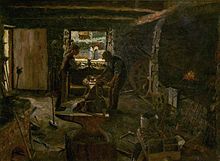
- Blacksmiths festival, an annual festival that takes place in Ivano-Frankivsk
- Blacksmith Scene (also, known as Blacksmith Scene #1 and Blacksmithing Scene)
- Bladesmith
- Hefaiston, one of the most important annual meetings of creative person blacksmiths in the world (Czech Republic)
- Ironmongery
- Makera Assada
- National School of Blacksmithing (United Kingdom)
- Silversmith
- St Cloudless's Day
- Whitesmith
- Worshipful Company of Blacksmiths
Footnotes
- ^ "blacksmith | Origin and significant of blacksmith past Online Etymology Dictionary". www.etymonline.com . Retrieved 2020-09-08 .
- ^ "Online Etymology Dictionary". Etymonline.com. Retrieved 2014-02-27 .
- ^ a b Davis, J.R. (1998). Metals Handbook, 2d Ed . Materials Park, OH 44073-0002: ASM International. ISBN0-87170-654-7.
{{cite volume}}: CS1 maint: location (link) - ^ Brigit - the Order of bards, Ovates and Druids
- ^ Bonnefoy, Yves (1992) [1981], Doniger, Wendy (ed.), "Asian Mythologies", Mythologies, University of Chicago Press 1991, p. 340, an edited translation based on Dictionnaire des mythologies et des religions des sociétés traditionelles et du monde antique.
- ^ "Re-create Information for Jerusalem The Emanation of The Giant Albion". William Blake Annal. Retrieved Sep 11, 2013.
- ^ Morris Eaves; Robert N. Essick; Joseph Viscomi (eds.). "Object description for "Jerusalem The Emanation of The Giant Albion, copy E, object xv (Bentley xv, Erdman xv, Keynes 15)"". William Blake Archive. Retrieved September 12, 2013.
- ^ "The Kalevala: Rune Nine. Origin of Fe". Sacred-texts.com. Retrieved 2014-02-27 .
- ^ Schaefer, Bradley Eastward. "Meteors That Changed the World". Meteors. SkyandTelescope.com. Archived from the original on 2014-02-22. Retrieved 2010-07-07 .
- ^ An Adjutant-Memoire to the Military machine Sciences volume i by Imperial Engineers, British Service, 1845, Col. G.K. Lewis, senior editor
- ^ # The Ordnance Transmission For The Utilise Of The Officers Of The Amalgamated States Ground forces, 1863 reprinted by Morningside Press 1995, ISBN 0-89029-033-4
- ^ # The ordnance manual for the employ of officers of the United States army, 1861, reprinted past Scholarly Publishing Function, University of Michigan Library, December 22, 2005, ISBN 1-4255-5971-9
- ^ Einhorn, David (2010). Civil War Blacksmithing. CreateSpace Publishers. ISBN978-1456364816.
- ^ Strelinger, Chas. A. (1895). A Volume of Tools. Detroit, Michigan: Chas. A. Strelinger & Company.
- ^ Revay, Pavel A. (2010). Umelecke Kovar. Prague, Czech Commonwealth: GRADA. ISBN9788024783277.
- ^ "Almost". BABA. 2013-08-04. Archived from the original on 2014-03-06. Retrieved 2014-02-27 .
References
- Andrews, Jack. New Edge of the Anvil, 1994.
- Einhorn, David, M. Civil War Blacksmithing: : Amalgam Cannon Wheels, Traveling Forge, Knives, and Other Projects and Information, 2010.
- McRaven, Charles. The Blacksmith's Craft, originally published in 1981 as Land Blacksmithing.
- Sims, Lorelei. The Backyard Blacksmith — Traditional Techniques for the Modern Smith, 2006.
- Holmstrom, John Gustaf. Mod Blacksmithing, Rational Equus caballus Shoeing and Wagon Making (With Rules, Tables, Recipes, Etc.)
External links
- Majestic Naval Museum - Ocean Your History - Blacksmiths
- Find Blacksmiths In the UK with The National Directory Of Blacksmiths
- "Be Your Own Blacksmith" , Popular Science, January 1949 basics of being a blacksmith
- (ABANA) The Artist Blacksmith's Association of N America, Inc.
- Family unit of English blacksmiths dating back to c1550.
- Blacksmith Scene (1893) (video)
- Forging of Chain by Two Blacksmiths (video)
0 Response to "I Am the Smith That Fashions a Weapon"
Post a Comment